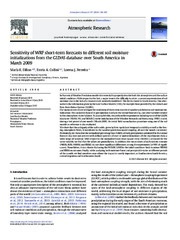Mostrar el registro sencillo del ítem
Sensitivity of WRF short-term forecasts to different soil moisture initializations from the GLDAS database over South America in March 2009
| dc.contributor.author | Dillon, María Eugenia | |
| dc.contributor.author | Collini, Estela Ángela | |
| dc.contributor.author | Ferreira, Lorena Judith | |
| dc.date.accessioned | 2017-02-14T18:05:32Z | |
| dc.date.available | 2017-02-14T18:05:32Z | |
| dc.date.issued | 2016-01-01 | |
| dc.identifier.issn | 0169-8095 | |
| dc.identifier.uri | http://hdl.handle.net/20.500.12160/123 | |
| dc.description | Artículo publicado en la Revista Atmospheric Research, Volume 167, 1 January 2016, páginas 196–207. | es |
| dc.description.abstract | In Numerical Weather Prediction models it is essential to properly describe both the atmosphere and the surface initial conditions. With respect to the last, a major issue is the difficulty to attain a correct representation of soil moisture due to the lack of a measurement network established. This fact is crucial in South America. One alternative is the information given by the Land Surface Models (LSM), for example those provided by the Global Land Data Assimilation System (GLDAS). Our main concern is to investigate the sensitivity of short-term numerical weather prediction to soil moisture initializations. The analysis is focused in precipitation mainly to the second forecast day, and other variables related to the atmospheric water balance. To accomplish this, we perform five experiments including some of the GLDAS databases (NOAH, VIC and MOSAIC) in the initialization of the Weather Research and Forecasting (WRF) model, during a test period of one month (March 2009). An initial field normalization procedure using one of the soil models as reference is also evaluated. We show that the ambiguity of the soil models, given by their spatial and temporal variability as well as the forcing atmospheric fields, is transferred to the weather prediction model coupling, all over the month considered. Particularly, we show that the normalized percentage bias (NBIAS) of daily precipitation calculated for the second forecast day does not present well-defined patterns of over or underestimations: all the experiments show a wide range of variation. With respect to the normalized root mean square error (NRMSE) calculated for the same variable, we find that the values are generally low. In addition, the mean values of each statistic measure (NBIAS, BIAS, NRMSE and RMSE) do not show significant differences among the experiments (at 99% of significance). Nonetheless, it was shown that using the MOSAIC LSM for the initial conditions leads to minor NRMSE and RMSE maximums. Finally, while analyzing both moisture fluxes and precipitable water at different periods of the month, we find sensitive areas where the impact is mostly important, as Southeastern South America, central Argentina and Northeastern Brazil. | en |
| dc.language.iso | eng | es |
| dc.publisher | Elsevier | es |
| dc.subject | SOIL MOISTURE INITIALIZATION | es |
| dc.subject | LAND SURFACE MODELS | es |
| dc.subject | NUMERICAL WEATHER PREDICTION | es |
| dc.subject | PRECIPITATION | es |
| dc.subject | ATMOSPHERIC WATER BALANCE | es |
| dc.subject | SOUTH AMERICA | es |
| dc.title | Sensitivity of WRF short-term forecasts to different soil moisture initializations from the GLDAS database over South America in March 2009 | es |
| dc.type | Article | es |
